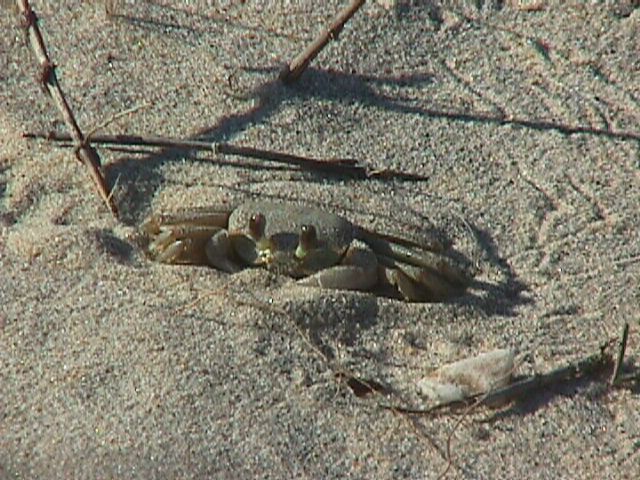
by Rick O'Connor | Jul 31, 2015
For locals along the coast ghost crabs are as common as mockingbirds and mourning doves. Before Ivan, when the dunes were larger and closer to the road, viewing the white crabs scouring across the road at night in your headlights forced all into defensive driving maneuvers. And for those who have ever tried to catch one, all would agree it is one of the fastest animals on the beach.
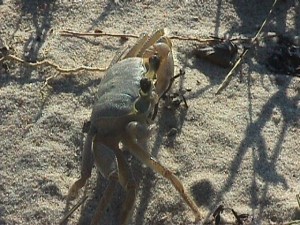
The common ghost crab. Photo: Virginia Institute of Marine Sciences
Ghost crabs (Ocypode quadrata) are members of the fiddler crab family. Like their fiddler crab cousins, they are more terrestrial than aquatic and dig burrows to protect themselves from predators and the intense heat of the midday sun. Though ghost crabs can be found in a variety of locations on the island, they are most frequently found between the mean high tide line and the upper portions of the primary dune line; typically on the Gulf side. Their “J” shaped burrows reach the water level below the sand and can run as deep as four feet. Larger individuals can dig deeper burrows and are often found further away from the water’s edge. These are crabs and thus still possess gills. Gills must be in contact with water in order to obtain needed oxygen. To do this ghost crabs have a gill chamber that will hold water for periods of time. The crabs can obtain water either at the bottom of their burrow or by running to the edge of the Gulf. And running is a good term for what they do. Once they have left the burrow they will lift five of their 10 legs above their head running on the remaining five. Running sideways they will have three in contact with ground in the direction they are going and two on the opposite side; if you look closely you can actually the remaining legs raised high in the air. When they tire, they will stop, make a 180° turn, and begin running again; resting their legs. They have reached speeds of 1.6 meters/second, which is 3.5 mph!
Ghost crabs are most active at night, though they are found at dawn and dusk and occasionally at midday. They feed on invertebrates at the surface zone such as mole crabs (sand fleas) and coquinas (bean clams). Dead fish and other animals found along the shoreline are also part of their diet, often dragging them back to their burrow. Unfortunately they are one of the predators of sea turtle hatchlings heading to the Gulf at night. Ghost crabs breed in late spring and early fall. The females will carry her developed eggs to the surf zone to release them. The developing young will return the following spring to mate and release their own eggs. Females may produce eggs in their second year but rarely live to do the same the third year. They are quite social with other crabs communicating, like their fiddler crab cousins, with body postures and claw movements. They are most active from March to December, plugging the entrance of their burrows and going dormant during the colder months of the year.
There has been concern about the impact of the oil spill on their numbers and the numbers of their prey, mole crabs and coquina. Our beaches did have small and large patches of oil that seeped down into the sand and then there were the methods used to remove the oil from the beach. At this point we do not know how hard their populations were impacted but scientists have collected data before and after the spill and are analyzing this now. However low their population dropped I am sure these resilient creatures will rebound and we will once again dodge them during our evening drives.
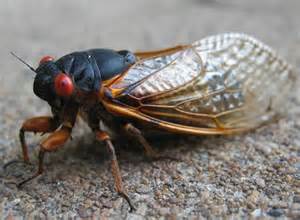
by Rick O'Connor | Jul 24, 2015
I was sitting on my back porch late in the afternoon this past week enjoying the breeze and the sunset when the familiar sound of the bugs some call “locust” began their buzzing songs. Not all would agree with me but I really enjoy the sound of these animals. They remind me of camping and warm summer evenings, they remind me of living in Florida. They have been with me all of my life and I quite enjoy hearing them – would actually miss them if there were not here.
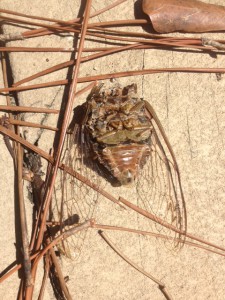
The adult body of a local cicada.
These bugs are not locust but a type of insect called cicadas, which is different from the “katydid” which is a different insect all together. Many who have grown up in Northwest Florida are quite familiar with their songs but not with the insect itself. Cicadas begin their lives in the trees – this is where the females lay their eggs. Most of them will find a split or tear in the twig tissue but others will actually make such a tear and here deposit their eggs. When they hatch they fall to the ground as an ant-sized larva. These larva burrow under the ground and move via burrows feeding on the sap and tissue of plant roots. Some species spend 2 years here, others as many as 17 years before they emerge. Like all members of Arthropoda these insects have external skeletons and must molt, or shed them, as they grow. Cicadas molt three times while living beneath the soil before emerging as a nymph. The nymph will climb a tree where they will molt once more becoming the winged adult some of us have seen. Many have found the empty cast of these molting nymphs clinging to the side of the tree. The males do most of the “singing” using drum-like structures called TIMBALS along their abdomen. These timbals are controlled by muscles and vary from species to species. The songs are species specific and are used to communicate with others but particularly the females, with whom he wishes to breed with before their lives come to an end in a few weeks. Landscapers and contractors have claimed that the sounds of their lawn equipment and power tools will sometimes attract cicadas and there is some evidence that it in fact it does… particularly females.
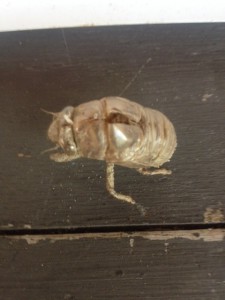
The empty molt of a cicada nymph.
There are many species of cicadas in the United States. One group will lay their eggs, the larva will drop and remain subterranean for 17 years emerging all at once! There are 19 species found in Florida and the mass emergence does not occur here. Our adults emerge every season, singing their songs, and relaxing our souls. I am glad they are here. Enjoy the summer.
by Les Harrison | Jul 18, 2015
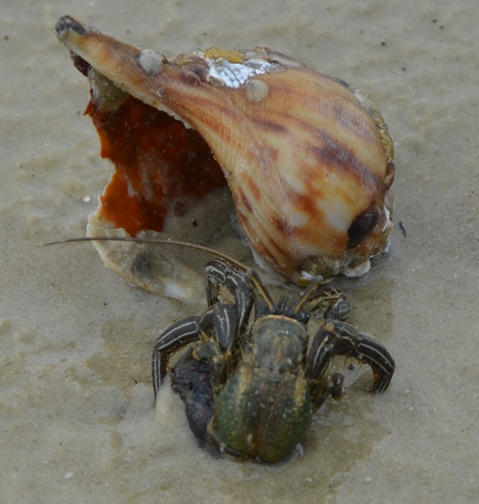
A room with a view: a stripped hermit crab sizes up a potential residence
Summertime in north Florida is good. Among the premium experiences are leisurely hours at the beach.
For many this is a period of relaxation and the opportunity to casually examine what the surf has thrown on the beach. It can be the culmination of a summer vacation or a weekend reprieve from the contemporary insanity of 2015’s workaday grind.
The hermit crab is one commonly encountered native creature which is slow-moving and hard to miss observing. It scuttles along the shallow coastal waters in search of its immediate needs.
In most cases it is the next meal which prompts this member of the Pagurus genus to fitfully crawl about in the borrowed disguise of a gastropod. They are not particular which shell they occupy just so long as it fits their size and is transportable.
Likewise, they are not especially particular about their meals. Hermit crabs are omnivores which relentlessly scavenge for anything digestible in the shallow waters of much of the world.
Their family includes about 1100 members which differ in size, color and housing choices. Some, in other regions, will even lodge in immovable locations and depend on the tidal currents to provide for their nutritional requirements.
When times are good and the hermit crab has plenty to eat, it will outgrow it’s the shell which fate provided for its use. The search for a replacement requires probing, luck and can produce aggressive behavior between hermit crabs if appropriately sized shells are in short supply.
Without the shell a hermit crab is an easy meal for other denizens of the deep. If the shell is too small, the hermit crab cannot grow properly or withdraw into the shell completely which exposes it to the unending stream of predators.
The upper portion of their bodies is covered with a hard exoskeleton, but their abdomen is soft and vulnerable to attack. The long and pliable abdomen is useful for firmly holding to a vacant snail shell which provides the necessary protection.
The technique has proven very successful for the hermit crabs as a whole. Fossil records indicate these crustaceans have existed since the last days of the dinosaurs.
While hermit crabs live alone in the shells they procure, they are commonly found in colonies and compete for a variety of necessary resources and mates. Their collective activity has attracted the attention of many young beach goers.
The small, shy creatures have held unending fascination for generations of children. The hide and seek nature of their behavior retreating into shells at the first appearance of a threat increases the enticement.
The temptation to return home with a unique and diminutive pet has proven irresistible for many. One can only guess how many parents have first learned of their child’s decision by the aroma of a deceased hermit crab.
It is a good thing the visit to the beach is relaxing. To learn more about hermit crabs contact the nearest UF/IFAS Extension Office.
by Les Harrison | Jul 18, 2015
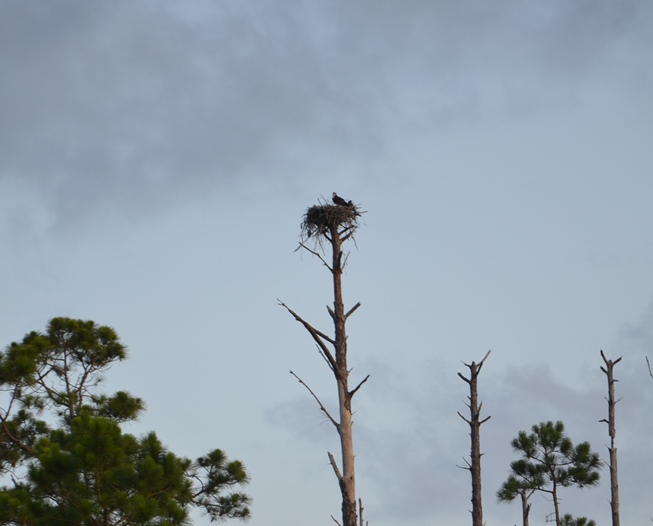
Osprey nesting sites are commonly near water, and their food source.
In north Florida water sports are a supreme pastime in summer. Fishing is among the most popular activity for all ages in this recreational realm.
Human anglers are not the only competitors seeking to land a trophy specimen. Ospreys, the local avian apex fisher, are literally plucking the fish from every river and body of water in the region.
Pandion haliaetus carolinensis is one of four osprey species worldwide and is native to north Florida. Geologic records in the area indicate a long residency and the possibility of extinct members of this genus who once lived in prehistoric Florida.
This aquatic predator is easily identified because of its size and nesting habits. Large specimens can have a six foot wingspan and their big nest are usually located in the tops of trees near a body of water.
The backs and wing tops of this bird are dark brown, but its underside is a snowy white. The head is white with a dark band over the eyes which gives the appearance of a mask.
Males and females are very challenging to distinguish individually as there are only small variations in their size and feather coloration. Side by side it is easier to see the difference in wing shape and body size.
As the several common names imply, the osprey’s diet is comprised of fish almost exclusively. Salt water catfish, mullet, spotted trout, shad, crappie and sunfish are some of the prey which stray into this bird’s sight when they swim too close to the water’s surface.
Osprey’s have the ability to hover in a nearly stationary position 100 feet or more above the water as they wait for their prey to move into the ideal position. When the fish is most vulnerable this bird drops almost vertically and securely clutches the fish in its talons.
Ospreys and owls are the only raptors, birds of prey, whose outer toes are reversible and which provide a highly effective gripping ability. A slippery fish is much less likely to escape when grasped by two talon-tipped toes on each side of the foot.
Their nest are large structures constructed of sticks. Ospreys commonly mate for life and will reuse nest for many years.
Utility poles, channel markers and other manmade locations with plenty of ground clearance and good visibility can be used by ospreys for nesting. Electrical power lines have proven problematic in a few cases if the birds contact the charged line and a grounding source.
Ospreys can be observed all year in Wakulla County and north Florida, especially near water bodies and shorelines. It is a safe bet they will leave with a good catch
To learn more about ospreys in north Florida contact your local UF/IFAS Extension.
by Judy Biss | Jul 18, 2015
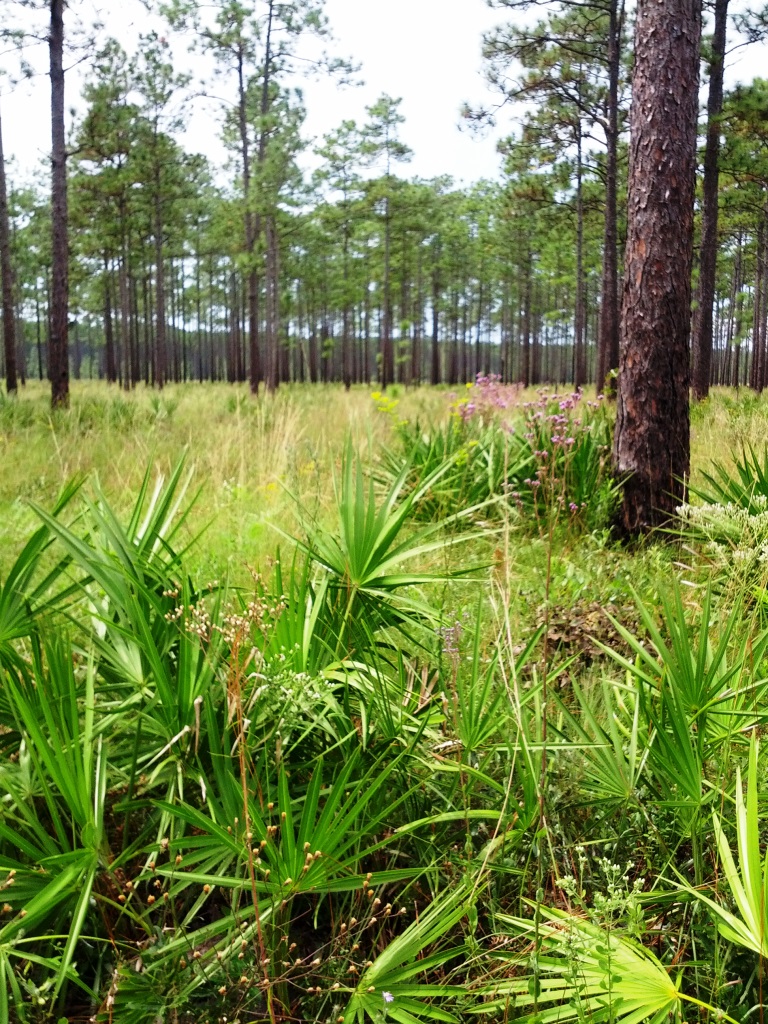
Woodlands and rangelands are important to both our economy and environment. Photo by Judy Ludlow
Most of us living in panhandle Florida recognize that our farmers and ranchers are committed to sustainable production of food, fiber, and fuel for generations to come, but how will farmers continue to be productive while sharing natural resources with an ever growing population and an intricate environment? How will Florida’s agricultural lands, rangelands, and woodlands continue to contribute to the quality of our environment and to our economy?
Florida Rangelands:
According to the USDA Natural Resources Conservation Service “Range and pasture lands are diverse types of land where the primary vegetation produced is herbaceous plants and shrubs. These lands provide forage for beef cattle….and other types of domestic livestock. Also many species of wildlife…depend on these lands for food and cover.” Florida’s rangelands and woodlands are a significant component of Florida’s agricultural industry.
According to the 2012 Census of Agriculture there were:
- 3,749,647 acres of permanent pasture and rangeland in Florida
- 1,368,171 acres of pastured woodland in Florida
Benefits of Rangelands:
Florida’s 5.1 million acres of agricultural rangelands and woodlands not only support the economy, but abundant wildlife too. These well managed lands are living systems sustaining livestock, wildlife, and healthy soils. Benefits of these lands include important economic and ecological services like reducing our carbon footprint, increasing water conservation, providing forage for livestock, habitat for wildlife and game, preservation of cultural heritage, and sustainable timber. Additionally, hunting, fishing, and wildlife viewing is a multi-billion dollar industry within which Florida’s rangelands play a significant role. Florida’s rangelands are also important for the continued survival of many threatened species like the Crested Caracara, Snail Kite, Gopher Tortoise, Florida Scrub-Jay, Eastern Indigo Snake, Roseate Spoonbill, Wood Stork, and Sandhill Cranes.
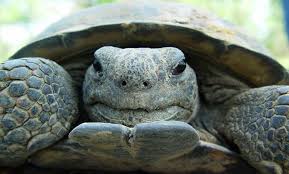
Gopher Tortoise. Photo by Chuck Bargeron, University of Georgia, Bugwood.org
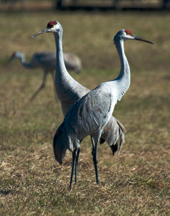
Sandhill Cranes in a North Florida pasture. UF/IFAS Photo by Josh Wickham.
Challenges to Florida’s Rangelands:
Threats to Florida rangelands include conversion into urban areas and fragmentation of large tracts of lands causing disconnection from other farmlands and natural areas. Contiguous, connected “wildlife corridors,” are important for many species of wildlife. Additionally, the establishment of non-native, invasive animals and plants; and alterations of natural and necessary processes such as fire, floods, and droughts, can disrupt the full economic and environmental potential of these lands.
Agricultural Best Management Practices and Education:
Today’s farmers use best management practices (BMPs) relying on up-to-date technologies and research to protect Florida’s unique natural resources, especially our precious water, while at the same time maximizing their production. BMPs are based on University of Florida Institute of Food and Agricultural Sciences (UF/IFAS) research and are practical, cost-effective actions that agricultural producers can take to conserve water and reduce the amount of pesticides, fertilizers, animal waste, and other pollutants entering our water supply. They are designed to benefit water quality and water conservation while maintaining or even enhancing agricultural production. According to the Florida Department of Agriculture and Consumer Services, for example, agricultural producers save 11 billion gallons of water each year by their conservation practices.
Many of Florida’s rangeland and woodland owners also take advantage of educational programs available to them such as the UF/IFAS Forest Stewardship Program. The mission of this multi-agency program is to help and encourage private landowners to manage their lands for long-term environmental, economic, and social benefits. According to their annual report: “In 2014 the Program reached 503 landowners and professionals directly with workshops and field tours. These landowners and professionals collectively own and/or manage over 2 million acres across Florida.”
Summary and Additional Resources:
Florida’s agriculture producers are deeply committed to being stewards of their lands and our surrounding environment. Their adoption and support of best management practices as well as continuing education is critical for sustainable production and also for feeding the world of the future.
For more information on this topic please see the following resources:
UF/IFAS Forest Stewardship Program
UF/IFAS Extension – Range Cattle Research and Education Center
UF/IFAS Extension – Best Management Practices
Florida Farm Bureau’s County Alliance for Responsible Environmental Stewardship Program (This Farm CARES)
Florida Department of Agriculture and Consumer Services – Best Management Practices
The Nature Conservancy – Florida Ranchlands
Food and Agriculture Organization of the United Nations – Grasslands and Rangelands
USDA Natural Resources Conservation Service










